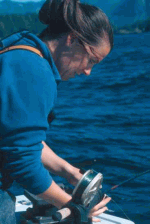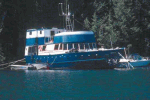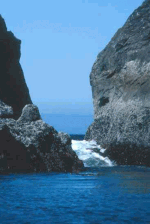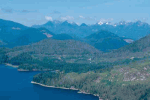written and photographed by Mary L. Peachin
Mar 2002, Vol. 6 No. 5
 Marilyn Murphy begins her orientation to salmon fishing on the stern of the Daleanne at the same time the black bear lumbers onto the beach. “Kyoquot,” she explains, ignoring the big animal, “translates to the land of many winds.” Unfazed by her guests’ distraction, she continues outlining British Columbia’s salmon and halibut regulations to the dozen hard-core anglers. “Don’t worry about him, that’s just Boo Boo,” the four-year-old resident bear. “He’ll be scavenging for shells and seaweed during low tide.”
Marilyn Murphy begins her orientation to salmon fishing on the stern of the Daleanne at the same time the black bear lumbers onto the beach. “Kyoquot,” she explains, ignoring the big animal, “translates to the land of many winds.” Unfazed by her guests’ distraction, she continues outlining British Columbia’s salmon and halibut regulations to the dozen hard-core anglers. “Don’t worry about him, that’s just Boo Boo,” the four-year-old resident bear. “He’ll be scavenging for shells and seaweed during low tide.”
It’s just another everyday moment on Surprise Island, where the Daleanne floats in the lee of a cove about five minutes by boat from the First Nations village of Kyoquot. For the next three nights, the 83-foot, 97,000-ton ship with 10 staterooms, four shared baths, and two showers will be home to twelve guests, most of who are return visitors and Daleanne devotees. They welcome old friends with enthusiastic laughs and hugs.
 The journey to Kyoquot has been an interesting one. After transferring from Seattle or Vancouver, anglers can fly or ferry to Campbell River, a village on the east coast of Vancouver Island. The adventure begins on the highway to Gold River, a two-lane road that winds through old-growth rainforest. There are beautiful views of emerald-green lakes, framed by the Vancouver Island range’s snowcapped peaks. Black bear, cougar, and enormous Roosevelt elk inhabit the area. The road ends a few miles beyond Gold River. Since the town paper mill shut down three years ago, many have left; the main street looks deserted. At the end of the road, a two-hour drive from Campbell River, is Nootka Sound and Air Nootkas floatplane. The next hour is spent flying 1000 feet above the Tahsis Inlet, then winding north along the Pacific coast to Kyoquot.
The journey to Kyoquot has been an interesting one. After transferring from Seattle or Vancouver, anglers can fly or ferry to Campbell River, a village on the east coast of Vancouver Island. The adventure begins on the highway to Gold River, a two-lane road that winds through old-growth rainforest. There are beautiful views of emerald-green lakes, framed by the Vancouver Island range’s snowcapped peaks. Black bear, cougar, and enormous Roosevelt elk inhabit the area. The road ends a few miles beyond Gold River. Since the town paper mill shut down three years ago, many have left; the main street looks deserted. At the end of the road, a two-hour drive from Campbell River, is Nootka Sound and Air Nootkas floatplane. The next hour is spent flying 1000 feet above the Tahsis Inlet, then winding north along the Pacific coast to Kyoquot.
With this crowd, the scenic journey is most likely taken for granted. These ten men and two women have come to fish. They are eager to meet their guides, jump into 17-foot boats, and head for some deep-water, downrigging, open-ocean salmon fishing.
 Captain Marilyn Murphy has been fishing since she was a kid. She’s been a guide for the family-operated Murphy Sportfishing almost half of her 26 years, and can tie knots, set out lines, find fish, and outfish almost anyone. She was taught by “one of the best,” her father Gordon—who, at 76, is still guiding in Barkley Sound near Ucluelet.
Captain Marilyn Murphy has been fishing since she was a kid. She’s been a guide for the family-operated Murphy Sportfishing almost half of her 26 years, and can tie knots, set out lines, find fish, and outfish almost anyone. She was taught by “one of the best,” her father Gordon—who, at 76, is still guiding in Barkley Sound near Ucluelet.
Taking a 97,000-ton ship through open seas in stormy conditions is not a trip for amateurs. Each spring for the past six years, Marilyn, who has a Master Limited captain’s rating, has motored the ship from the family’s lodge on the Stamp River in Point Alberni. Offshore fishing can be rugged around Kyoquot. Twenty-five-knot winds are the norm, and Marilyn will fish 10-foot seas with northwester lies up to 40 knots. (Anglers with queasy stomachs can find calmer waters near the shore in the lee of the Barrier Islands, a group of lava rock formations that provides some protection from the elements.)
Betty Johnson, who cooks for logging camps in the winter, spends her summers cooking for the Murphy’s. Her small galley produces family-style meals with homemade breads and deserts. The meals are minutely planned, as the provision boat comes only once a week. Anglers are always eager to taste some of her fresh salmon or halibut.
 The captain’s introduction complete and an excellent meal consumed we head out to troll with downriggers, as deep as 120 feet for Chinook or king salmon. Marilyn’s boat, the Dolphin, is a Campion Explorer equipped with a 150-horsepower Yamaha plus a 9.9-horsepower four-stroke trolling engine. She has a global positioning system, or GPS, radar, and a fish finder. Marilyn uses Shimano fishing gear, a single-action reel with 30-pound test line.
The captain’s introduction complete and an excellent meal consumed we head out to troll with downriggers, as deep as 120 feet for Chinook or king salmon. Marilyn’s boat, the Dolphin, is a Campion Explorer equipped with a 150-horsepower Yamaha plus a 9.9-horsepower four-stroke trolling engine. She has a global positioning system, or GPS, radar, and a fish finder. Marilyn uses Shimano fishing gear, a single-action reel with 30-pound test line.
The captain scans the water, searching for fish as she guides the boat. She’s looking for birds, especially the Merlette, a species that dives to 120 feet. She’s also looking for bait on the surface, or fish appearing on her fish finder. She knows the topography of the reefs and ridges and where the salmon tend to feed. This area produces good fishing for salmon that have not yet headed to their spawning rivers, and anglers almost always catch their limits, sometimes in a single day.
Salmon fed on pilchards, needlefish, and squid, so Marilyn decides on a “hoochie” that resembles a squid, with a bright colored flasher to attract the fish. Twenty-pound Chinook took the bait immediately and while I was releasing fish, other anglers had some of their best fishing of the trip, and salmon to take home. We start trolling in late afternoon and by the time we head for the ship fours hours later, Kyoquot is completely shrouded by fog. Marilyn has to rely on the boat’s radar to navigate some shallow channels with treacherous rocks.
Our second day, the group opts for some light-tackle Coho fishing. Since we released the salmon on the first day, we were not restricted to fishing offshore where deeper (120-feet) downrigging is required. Although our target today hatchery-bred Coho, their back fin clipped can be kept, Marilyn gently releases them. This type of fishing produces a lot better results, plus lighter tackle is a lot more fun to use.
 We return to shore with voracious appetites. In the village, hanging flowerpots mark Miss Charlie’s, where boaters heading up the west coast of British Columbia make it a point to drop in for some home cooking. Miss Charlie is a 37-year-old harbor seal rescued as an abandoned pup. Nursed in the bathtub of Esko and Lucy Kayra, she lolls on the rocks at low tide, visits everyone’s dock, and chases pilchards in the bay when the tide is in. Charlie is the village mascot, according to the Kayras’ daughter Sam, who operates the restaurant. There is no other business in town, not even a fuel dock.
We return to shore with voracious appetites. In the village, hanging flowerpots mark Miss Charlie’s, where boaters heading up the west coast of British Columbia make it a point to drop in for some home cooking. Miss Charlie is a 37-year-old harbor seal rescued as an abandoned pup. Nursed in the bathtub of Esko and Lucy Kayra, she lolls on the rocks at low tide, visits everyone’s dock, and chases pilchards in the bay when the tide is in. Charlie is the village mascot, according to the Kayras’ daughter Sam, who operates the restaurant. There is no other business in town, not even a fuel dock.
Our final morning, we decide to fish behind the lee of Spring and Thornton Island. We begin by trolling for salmon with 9-weight fly rods, trailing flashers, and fly streamers called buck tails. I find the whir of salmon striking the fly even more exciting than the visual cue of the bent rod in deep-water fishing. I take a break and look around, enjoying the shore’s black-lava rocks covered with gulls and cormorants, the spruce trees capping each small island, the leaves of bull kelp gleaming in the sunshine. Marilyn comes up at my side. “I love the smell of low tide,” she says, inhaling the perfume of kelp, eelgrass, barnacles, and starfish. She takes another breath and smiles. “We’ll be doing some gardening today,” she laughs, referring to de-weeding our flies.
Marilyn loves her life and loves fishing. Along with her husband, brother, and four other guides, she’ll work nonstop from June to August before heading the boat back to Point Alberni. It’s a long season, but she’ll be ready for some fall river fishing, followed by winter steelhead fishing in their Stamp River Lodge. Sounds exhausting, right? Ah, but in November, she and her husband, Matt, take a month of vacation.
They go fishing in the tropics.
For further information, e-mail [email protected] or go to www.murphysportfishing.com.
